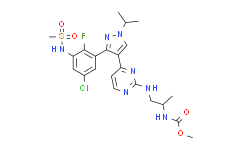| Cas No.: | 1269440-17-6 |
| Chemical Name: | Encorafenib |
| Synonyms: | methyl N-[(2S)-1-[[4-[3-[5-chloro-2-fluoro-3-(methanesulfonamido)phenyl]-1-propan-2-ylpyrazol-4-yl]pyrimidin-2-yl]amino]propan-2-yl]carbamate;(S)-methyl (1-((4-(3-(5-chloro-2-fluoro-3-(methylsulfonamido)phenyl)-1-isopropyl-1H-pyrazol-4-yl)pyrimidin-2-yl)amino)propan-2-yl)carbamate;UNII-8L7891MRB6;SureCN8228295;KB-145917;methyl N-[(2S)-1-({4-[3-(5-chloro-2-fluoro-3-methanesulfonamidophenyl)-1-(propan-2-yl)-1H-pyrazol-4-yl]pyrimidin-2-yl}amino)propan-2-yl]carbamate;LGX 818;(LGX818);Encorafenib (LGX818);Lgx-818;Encorafenib;Encorafenib(LGX-818);LGX818;Braftovi;8L7891MRB6;Carbamic acid, N-[(1S)-2-[[4-[3-[5-chloro-2-fluoro-3-[(methylsulfonyl)amino]phenyl]-1-(1-methylethyl)-1H-pyrazol-4-yl]-2-pyrimidinyl]amino]-1-methylethyl]-, methyl ester;(S)-methyl (1-((4-(3-(5-chloro-2-fluoro-3-(methylsulfonamido)phenyl)-1-isopropyl-1H-pyrazol-4-yl)pyrimidin-2-yl)amino)propan-2-yl)carbamate.;Encorafenib [USAN:INN];Braftovi (TN) |
| SMILES: | ClC1C([H])=C(C(=C(C=1[H])C1C(C2C([H])=C([H])N=C(N=2)N([H])C([H])([H])[C@]([H])(C([H])([H])[H])N([H])C(=O)OC([H])([H])[H])=C([H])N(C([H])(C([H])([H])[H])C([H])([H])[H])N=1)F)N([H])S(C([H])([H])[H])(=O)=O |
| Formula: | C22H27ClFN7O4S |
| M.Wt: | 540.0107 |
| Sotrage: | 2 years -20°C Powder, 2 weeks 4°C in DMSO, 6 months -80°C in DMSO |
| Description: | Encorafenib (LGX818) is a highly potent RAF inhibitor with selective anti-proliferative and apoptotic activity in cells expressing BRAFV600E (EC50=4 nM). |
| In Vitro: | Encorafenib (LGX818) is a potent drug that can prevents diseases or disorders associated with abnormal or deregulated kinase activity, particularly diseases or disorders that involve abnormal activation of B-Raf[1]. Encorafenib (LGX818) (10 nM) suppresses the ERK/MAPK pathway and displays marked inhibition of pERK in A375, G361 and SK-MEL-24 cells. 10 nM Encorafenib (LGX818) treatment for 12 days potently inhibits colony formation in A375, G361 and SK-MEL-24 cells, but not in RPMI7951 and C8161 cells. Encorafenib (LGX818) treatment induces a steady increase in the β-catenin level in G361 cells over time[2]. |

 To enhance service speed and avoid tariff delays, we've opened a US warehouse. All US orders ship directly from our US facility.
To enhance service speed and avoid tariff delays, we've opened a US warehouse. All US orders ship directly from our US facility.




















